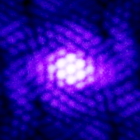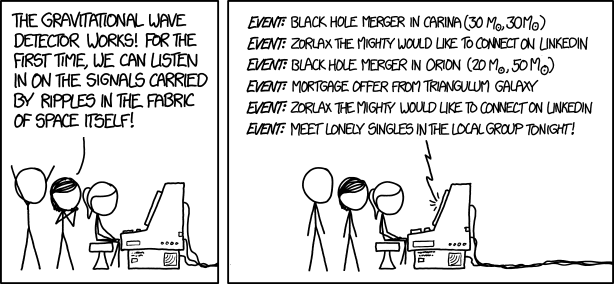|
Science and Astronomy Questions
|
|
| steeljaw354 | Date: Tuesday, 16.08.2016, 17:02 | Message # 751 |
 World Builder
Group: Users
 Pirate
Pirate
Messages: 862
Status: Offline
| It probably can't without intelligent intervention, I mean can it be done with intervention somehow?
|
| |
| |
| PlutonianEmpire | Date: Tuesday, 16.08.2016, 18:58 | Message # 752 |
 Pioneer
Group: Users
 United States
United States
Messages: 475
Status: Offline
| Quote Watsisname (  ) Another factor beyond humidity and CAPE is a lifting mechanism -- something to get the air moving upwards to start the convection. Fronts, convergence, or low pressure systems can act to lift the air (cold fronts especially force air upwards rapidly). But some of the most powerful storms in the US plains states occur when the lower atmosphere is extremely humid, but capped under a stable layer of warmer air. This is like putting a lid on a pressure cooker, building up lots of energy as daylight heats the surface, and eventually, if the capping inversion is broken, the convection starts vigorously. Violent supercell storms can pop up in literally minutes.
Would an airliner climbing out from take off or descending towards landing at a big airport contribute at all to breaking inversion caps? It makes me wonder if a Boeing 747 taking off from Denver would cause tornadoes in Nebraska from this kind of butterfly effect.
Quote Watsisname (  ) There a way to get water to form droplets without condensation nuclei, but it doesn't usually happen in atmospheres. You can observe it every time you open a soda or beer bottle, as the sudden fog that appears at the top. (I love this article, by the way.) The sudden expansion of the air cools it very severely (well below freezing!) and allows the water molecules to stick together and form droplets. The interesting thing about this is that all the droplets are basically identical -- the same size. This is "homogeneous nucleation". A very different kind of cloud than what we see in the sky.
Reminds me of when I bring ice cold drinks when I go to work at Burger King. Minnesota gets pretty humid in the summer and on hot and humid days, my whole entire water bottle would be shedding fog even when closed, since the employee lounge is next to the kitchen, where it gets *very* warm. Pretty cool. 
And I watched both videos. Awesome 
Specs: Dell Inspiron 5547 (Laptop); 8 gigabytes of RAM; Processor: Intel® Core™ i5-4210U CPU @ 1.70GHz (4 CPUs), ~2.4GHz; Operating System: Windows 7 Home Premium 64-bit; Graphics: Intel® HD Graphics 4400 (That's all there is :( )
|
| |
| |
| midtskogen | Date: Tuesday, 16.08.2016, 20:41 | Message # 753 |
 Star Engineer
Group: Users
 Norway
Norway
Messages: 1674
Status: Offline
| Quote steeljaw354 (  ) It probably can't without intelligent intervention, I mean can it be done with intervention somehow?
Sure, given really unintelligent intervention.
Quote PlutonianEmpire (  ) Would an airliner climbing out from take off or descending towards landing at a big airport contribute at all to breaking inversion caps? It makes me wonder if a Boeing 747 taking off from Denver would cause tornadoes in Nebraska from this kind of butterfly effect.
It sounds highly unlikely. Inversion caps can be very hard to break. They're rather very good at killing the butterfly effects. This is most evident in winter when ice storms can last for days. Huge wet weather systems can sweep across an area yet unable to break the inversion. An airliner is nothing compared to that.
Quote PlutonianEmpire (  ) Reminds me of when I bring ice cold drinks when I go to work at Burger King. Minnesota gets pretty humid in the summer and on hot and humid days, my whole entire water bottle would be shedding fog even when closed, since the employee lounge is next to the kitchen, where it gets *very* warm. Pretty cool.
I arrived in Mumbai once during the rainy season in the middle of the night, above 30 degrees C and very very foggy, and two things I remember about arriving in the hotel room are: 1: Smog - it wasn't a big room, but when I sat in one corner of the room I could actually see the smog across the room. 2: For me the air was unbelievably sticky and I reached for a soda in the minibar to cool me down. I put the cool can on the table and it was steaming heavily, forming its own little cloud around itself. Coming from a relatively cool country these were quite exotic experiences. 
NIL DIFFICILE VOLENTI

Edited by midtskogen - Tuesday, 16.08.2016, 20:42 |
| |
| |
| Watsisname | Date: Tuesday, 16.08.2016, 21:30 | Message # 754 |
 Galaxy Architect
Group: Global Moderators
 United States
United States
Messages: 2613
Status: Offline
| I agree with midtskogen; I think the effect of an airliner on an inversion is pretty much nil. They are stable, rather than unstable or semi-stable, because it's the warm air on top of cooler air.
However, airliners can have a very large effect on a cloud layer, which isn't as commonly seen:
Fallstreak hole
Quote midtskogen (  ) I reached for a soda in the minibar to cool me down. I put the cool can on the table and it was steaming heavily, forming its own little cloud around itself.
That's pretty... *puts on sunglasses*... cool. 

|
| |
| |
| Alek | Date: Tuesday, 16.08.2016, 21:43 | Message # 755 |
 Pioneer
Group: Users
 United States
United States
Messages: 326
Status: Offline
| Quote Watsisname (  ) It'd be very hard for a terra with an atmosphere to have no CCNs at all.
This is why, in Star Trek Voyager, in the beginning of the series, were so surprised to find a planet such as Ocampa: it had no weather whatsoever, not because there was no water on the planet but because there was nothing for clouds to condense from. Turns out this wasn't natural, but a result of a disaster...What kind of disaster could possibly wipe a planet of the atmosphere's CCNs for long timescales, especially when the planet becomes desert and dust is able to blow into the atmosphere?
Living among the stars, I find my way. I grow in strength through knowledge of the space I occupy, until I become the ruler of my own interstellar empire of sorts. Though The world was made for the day, I was made for the night, and thus, the universe itself is within my destiny.
|
| |
| |
| Watsisname | Date: Wednesday, 17.08.2016, 04:27 | Message # 756 |
 Galaxy Architect
Group: Global Moderators
 United States
United States
Messages: 2613
Status: Offline
| I think it is not possible. There are just too many ways to produce CCN, and they have such low terminal velocities that the atmosphere would have to be absolutely free of wind and convection for them to fall out. To give an idea, the typical terminal velocity of a cloud droplet is on the order of centimeters per second, which is easily overcome by thermals.
For a cloud condensation nucleus, it's on the order of micrometers per second, or centimeters per day. So if there's any mechanism to generate them, they'll go everywhere. Even in the extremely clear air of the Antarctic, there's enough of them around to generate clouds.
I guess the one sure-fire way to remove a planet of its CCN would be to freeze or blow off its atmosphere entirely. 

|
| |
| |
| JackDole | Date: Wednesday, 17.08.2016, 20:52 | Message # 757 |
 Star Engineer
Group: Local Moderators
 Germany
Germany
Messages: 1742
Status: Offline
| Quote steeljaw354 (  ) What makes you think that aliens would use radio? They may use something completely different that we are missing in our searches for life. Maybe they evolved past a physical state? And are invisible to us with no proof of their existence?
Nothing makes me think that. But We know of no hypercom, so we can not look for hypercom signals. We have to look for normal radio signals.
But who knows? When near the star a ship in the warp goes, or comes out of warp, perhaps we could receive a signal thereof. For example, gravitational waves. 
Although our scientists would surely find a natural explanation for such signals. 
Don't forget to look here.

|
| |
| |
| steeljaw354 | Date: Wednesday, 17.08.2016, 21:28 | Message # 758 |
 World Builder
Group: Users
 Pirate
Pirate
Messages: 862
Status: Offline
| Maybe the reason nobody has responded is because they don't communicate on the frequency we use? Or they don't know of it for some reason.
|
| |
| |
| Watsisname | Date: Thursday, 18.08.2016, 03:13 | Message # 759 |
 Galaxy Architect
Group: Global Moderators
 United States
United States
Messages: 2613
Status: Offline
| Quote JackDole (  ) Nothing makes me think that. But We know of no hypercom, so we can not look for hypercom signals. We have to look for normal radio signals.
But who knows? When near the star a ship in the warp goes, or comes out of warp, perhaps we could receive a signal thereof. For example, gravitational waves.


|
| |
| |
| midtskogen | Date: Thursday, 18.08.2016, 05:13 | Message # 760 |
 Star Engineer
Group: Users
 Norway
Norway
Messages: 1674
Status: Offline
| Quote steeljaw354 (  ) Maybe the reason nobody has responded is because they don't communicate on the frequency we use? Or they don't know of it for some reason.
Our signals are weak. We would hardly be able to detect such signals light years away ourselves. And we're switching to digital transmission aiming to remove the redundancies, which means that the signals will be indistinguishable from noise. Not to mention fiber.
And many would argue that it would be wise to keep radio silence.
NIL DIFFICILE VOLENTI

|
| |
| |
| Alek | Date: Thursday, 18.08.2016, 05:37 | Message # 761 |
 Pioneer
Group: Users
 United States
United States
Messages: 326
Status: Offline
| Quote Watsisname (  ) I think it is not possible. There are just too many ways to produce CCN, and they have such low terminal velocities that the atmosphere would have to be absolutely free of wind and convection for them to fall out. To give an idea, the typical terminal velocity of a cloud droplet is on the order of centimeters per second, which is easily overcome by thermals.
For a cloud condensation nucleus, it's on the order of micrometers per second, or centimeters per day. So if there's any mechanism to generate them, they'll go everywhere. Even in the extremely clear air of the Antarctic, there's enough of them around to generate clouds.
I guess the one sure-fire way to remove a planet of its CCN would be to freeze or blow off its atmosphere entirely.
Hm...guess that wasn't so realistic, then...What about the atmosphere being wiped of water vapor instead, would enough to make clouds be able to get into the atmosphere before the lakes and seas become groundwater, even if the larger bodies of water weren't all that large?
Quote midtskogen (  ) many would argue that it would be wise to keep radio silence.
Surely a more advanced civilization would be able to have stronger radio signals, maybe this is why we don't hear anything, because they keep quiet to their planet purposely?
Also, Would it be possible to use Gamma Rays to commuinicate somehow? They're very energetic, but are more precise and could maybe be used to have more pinpoint communications if the over-energeticity issue could be solved, plus they would easily be distinguishable from background noise since not very much makes strong gamma ray output...That also raises the question, could GRBs be alien signals that are pointed directly at us, but are so quick in the short GRBs that they look more like a large supernova, and the long ones being a very long transmission but each "on/off cycle" (aka binary) being so subtle due to our lacking f precision, that it doesn't look like an intelligent signal?
Living among the stars, I find my way. I grow in strength through knowledge of the space I occupy, until I become the ruler of my own interstellar empire of sorts. Though The world was made for the day, I was made for the night, and thus, the universe itself is within my destiny.
|
| |
| |
| PlutonianEmpire | Date: Thursday, 18.08.2016, 05:48 | Message # 762 |
 Pioneer
Group: Users
 United States
United States
Messages: 475
Status: Offline
| Quote Watsisname (  )
When I conquer the universe over the next 52,000 years (  ), something like this will be entirely plausible. ), something like this will be entirely plausible. 
Specs: Dell Inspiron 5547 (Laptop); 8 gigabytes of RAM; Processor: Intel® Core™ i5-4210U CPU @ 1.70GHz (4 CPUs), ~2.4GHz; Operating System: Windows 7 Home Premium 64-bit; Graphics: Intel® HD Graphics 4400 (That's all there is :( )
Edited by PlutonianEmpire - Thursday, 18.08.2016, 05:51 |
| |
| |
| Tac1017 | Date: Thursday, 18.08.2016, 21:19 | Message # 763 |
 Explorer
Group: Users
 United States
United States
Messages: 167
Status: Offline
| what is the minimum and maximum amount of oxygen a planet needs to be breathable, nd the max amount of carbon dioxide? the new atmosphere feature is making my terra hunting harder.
The Terra Hunter of the Milky Way!
(By the way, I was born in 2001, NOT 1972 XD)
|
| |
| |
| Banana | Date: Thursday, 18.08.2016, 22:19 | Message # 764 |
 Astronaut
Group: Users
 United States
United States
Messages: 56
Status: Offline
| For humans and with air pressure similar to Earth, I believe oxygen levels can range from seventeen percent to around forty percent without too many side effects. Carbon dioxide should be under two percent.
In real life, of course. I am not sure what the requirements are in SE.
Hello.
Edited by Banana - Thursday, 18.08.2016, 22:21 |
| |
| |
| Watsisname | Date: Friday, 19.08.2016, 00:20 | Message # 765 |
 Galaxy Architect
Group: Global Moderators
 United States
United States
Messages: 2613
Status: Offline
| 17% O2 is like being at 2000m altitude. Humans can survive permanently up to about 5000 or 6000 meters, which is a pressure of about 55-50% of sea level, or 11% O2 concentration at sea level pressure. You would feel effects if subjected to that immediately (even fatal), but you can acclimate to it.
Maximum CO2 of a few percent is good. 5% is where it is considered toxic, but even at 1% you feel effects -- basically increased breathing rate and some tiredness. Maximum O2 is harder, there's actually no hard established limit to my knowledge. We can breathe 100% O2 for a little while, but it does have toxicity in the long term. For permanence, probably 30-40% is safe I would guess.
Quote Alek (  ) What about the atmosphere being wiped of water vapor instead, would enough to make clouds be able to get into the atmosphere before the lakes and seas become groundwater, even if the larger bodies of water weren't all that large?
For given values of 'not that large', yes, easily.  The amount of water stored in the atmosphere is surprisingly small. If you precipitated it all out of Earth's atmosphere, it'd be only a few centimeters deep! The amount of water stored in the atmosphere is surprisingly small. If you precipitated it all out of Earth's atmosphere, it'd be only a few centimeters deep!
So, if a few cm of seas and lakes (divided by what fraction of the surface area seas and lakes cover) is able to evaporate (and it evaporates very quickly, if there is no water in the air) before all going underground (percolation into the subsurface is generally slow), you will restore the water vapor in the air.

|
| |
| |